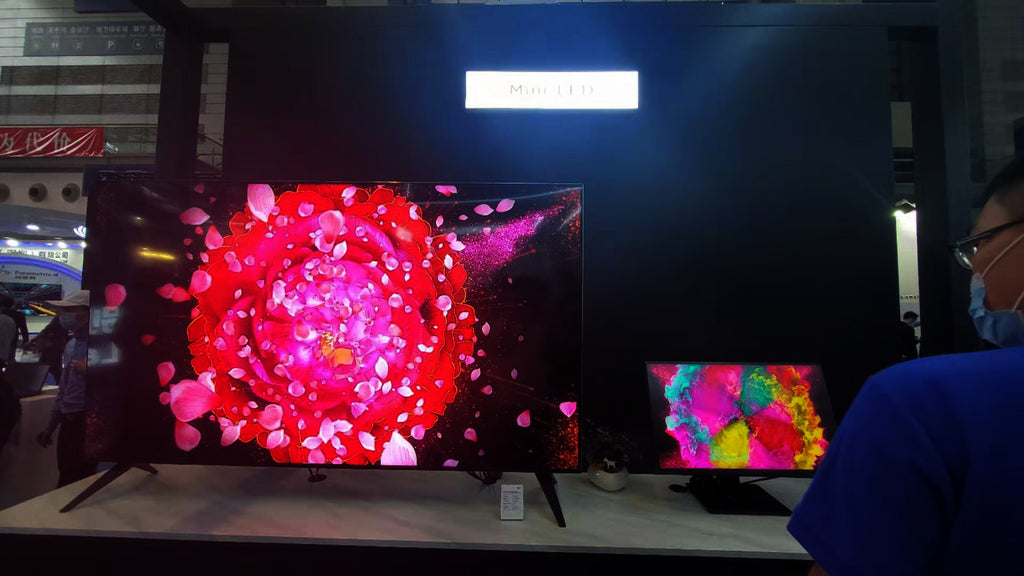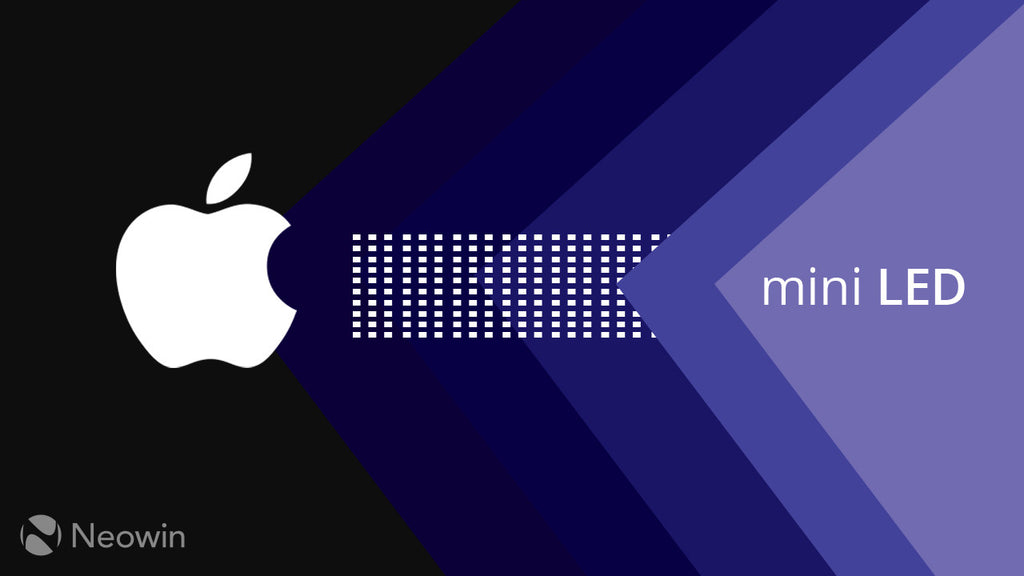Macbook 2021 with Mini LED Screen Panel
Prediction: Macbook Pro 15.6" with M1 chip and mini LED will be launched at the end of 2021
In CHTF 2020, BOE present a 8K TV, a 27" monitor and a 15.6" laptop with mini LED panel inside. As the worker said, the mini LED panel will be mass manufacutured in the next year. Mini LED an Micro LED will be the next generation of display.

What is Mini LED?
It was originally proposed by a company called Epistar for LEDs with a size of approximately 10 mm. At 100 microns it is also known as a "sub-millimeter light-emitting diode". Mini LEDs offer an improvement over traditional LED backlights.
Mini LED displays use LED backlights to provide the main source of luminance, which is transmitted to us via an LCD matrix and a set of color filters to display the image on the screen. Due to the dramatic reduction in LED size, Mini LED-based TVs use thousands of LEDs to power their backlight.
Conventional LEDs are used for illumination and as backlighting modules for displays. Mini LEDs are used for display backlighting applications to achieve energy-efficient, thinner HDR (high dynamic range) displays and notch-shaped display designs. It is used in smartphones, automotive displays, TVs and gaming laptops.
Benefits or Advantages of Mini-LED
The following are the advantages or benefits of Mini LEDs.
The mini makes it easier to mass produce mini LEDs than mini LEDs.
All existing equipment can be reused for mass production.
The mini LEDs are very economical due to their huge potential in LCD displays.
The cost of a mini LED backlight is about 70 to 80 percent of the cost of an OLED TV panel.
Micro has a higher yield compared to Micro LED.
offers it provides high dynamic range.
➨Mini LEDs are much smaller in size.
➨MiniLED displays have better control over local dimming, so some parts of the screen can be completely blacked out.
offers it provides better contrast, better brightness and better black levels.
In addition to saving power, Mini LED products are as thin as OLED products.
Disadvantages or drawbacks of Mini LED
The following are the advantages and disadvantages of Mini LEDs.
➨MiniLED backlights use about 18K to 20K LEDs. 65-inch LCD panels with such backlights, for example, would greatly consume the production capacity of LED chip manufacturers.
➨MiniLED is expensive compared to regular LED types. It costs 20% more than an LCD panel.

Reliable Apple analyst Ming Chi Kuo received a new investor report today, in which he focused his remarks on Apple's plans to transition to mini-LED display technology and the possibility that Apple could release 2 or 3 new chargers in 2021. Kuo reported today that the transition to mini-LEDs will be faster than initially expected.
First, Kuo significantly revised his forecast for Apple device shipments using mini-LED display technology. Kuo had previously reported that Apple would ship 2 million to 3 million units in 2021 and deliver 4 million to 5 million units in 2022. Now, Kuo says Apple will ship 10 million to 12 million units in 2021, followed by 25 million to 280,000 units. It will reach 1 million units in 2021.
Guo added two reasons.
1. Cost improvements over the next two years will be better than expected.
2. MacBook mini-LED panel adoption will be better than expected.
Kuo said Apple will launch two new MacBook Pro models in 2021 with new form factors, both of which will have mini-LED panels. Apple will also launch a "new, cheaper MacBook Air" with mini-LEDs in 2022.
The analyst said the MacBook lineup will be the main driver of mini-LED panel shipments, because "the MacBook's mini-LED penetration and shipment growth is better than that of the iPad," Kuo predicted. With Silicon and the new form factor, shipments of MacBooks will grow dramatically by 100% per year to between 300-35 million units within three years."
Kuo explains, "Since the cost of Apple Silicon is significantly less than the cost of an Intel CPU, using Apple Silicon offsets the increased cost of using a mini LED panel."
As an update, the mini-LED is a new form of backlighting for LCD screens. It offers many of the same advantages as OLEDs, but typically provides higher brightness, higher power efficiency, and a lower risk of screen burn-in.
Apple Camp Coverage hinted that the company's iPad and Mac laptop lineup could use Mini-LED displays by the end of 2021. The company is reportedly looking to Epistar and Sanan Optoelectronics as potential suppliers. As an emerging technology, these new displays will be very expensive at first. But costs are likely to come down in 2021 and 2020, so we may see more manufacturers adopting them across product segments in the next few years.
Sounds interesting, but what exactly is a Mini-LED? What advantages does it have over other display technologies such as LCD and OLED? Read on to find out.
What is Mini-LED technology?
The name gives the game a win in a way. Mini-LEDs use very small LEDs to produce light for the display. The origins of this new technology can be traced back to traditional backlit LCD technology. In addition to using a single large or multiple smaller localized dimming backlights, Mini-LEDs use thousands of tiny LED backlights to provide extremely superior localized dimming characteristics. To meet the Mini-LED classification, these backlight diodes are all less than 0.2mm in span.
Local dimming is important for LCD displays because backlight bleeding causes black and contrast degradation compared to OLED displays, where every pixel is on and off. This is a hybrid approach, designed to mimic the emission characteristics of OLEDs, but with less design complexity. Think of it as the best alternative to OLEDs for LCDs. However, do not confuse it with Micro-LED technology, which is tightly integrated with OLEDs. But it will be more in a minute.
Shifting to thousands instead of hundreds of tiny backlight sources allows for deeper blacks, higher contrast and brighter panels. The HDR content is great. All thanks to the smaller components. Mini-LED technologies can also be easily scaled from small to large panels, as there are no meaningful limits on the size and density of the backlight. However, they are still bound by the size limitations of the LCD matrix for converting white backlight to color. But this has nothing to do with small consumer electronics.
Mini-LEDs improve "local dimming" with thousands of miniature backlight diodes.
Mini-LED vs Micro-LED - New LCD vs OLED
Mini-LEDs are very different from Micro-LEDs. The former is based on LCD technology and uses smaller diodes for backlighting. The latter is a development of OLED, which uses smaller, brighter individual red, green, and blue LEDs to emit colored light directly. In other words, each pixel generates its own light through the Micro-LED, while the Mini-LED still uses an LCD matrix to filter the backlight, but the backlight offers more control than a traditional LCD.
This makes the production of Mini-LEDs more practical than Micro-LEDs, so they should be more affordable. On large televisions, placing many tiny OLEDs on the display works well, but this proves difficult in the smaller, high pixel density displays used in laptops and smartphones. The Mini model is not limited by pixel density and is therefore unlikely to suffer from these production difficulties. As such, it should be better suited for smaller form factors. Although only a few commercial TV products currently use the technology.
Micro LEDs still have an advantage in terms of contrast and deepest blacks, but the price is much higher. Importantly, the distance between LCDs and OLEDs can be reduced with Mini-LEDs.
Why switch to these new displays?
Ultimately, all of this boils down to excellent image quality without costing a fortune. OLEDs may be better than LCDs, but they are still quite expensive. It's also not always the first choice for high-density laptop and tablet displays, especially for peak brightness. Micro-LED is a superior technology on paper, but even for Apple it is currently too expensive. Now don't forget the manufacturing difficulties of smaller sizes, either.
The Mini-LED aims to provide the best of both worlds. Match the image quality and contrast of OLEDs, and exceed the brightness of OLEDs, without paying any price. This type of early display will still be expensive, but in the next few years, the technology will become more affordable. At that time, traditional LCDs will be further relegated to the budget market.
Of course, Mini-LED is only one of a handful of new display technologies entering the market. The list includes quantum dot (QLED) displays and flexible OLEDs for foldable phones, and form factor is still the biggest limitation when it comes to new phone display technologies. But keep an eye on display technologies for tablets and laptops to get an idea of what the next generation of devices might be using.

Leave a comment